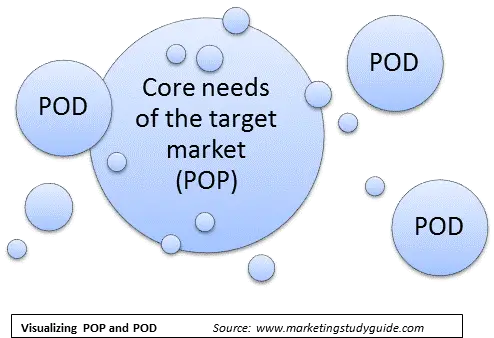Contents
What are points-of-difference (POD)?
When deciding upon a brand’s/product’s positioning in the marketplace, the organization must ensure that end positioning has both sufficient points-of-parity (POP) and points-of-difference (POD). What this means is that you want the brand/product to be consider equal/similar (on par with, hence the word ‘parity’) with the major offerings in the category for the key attributes (POP), but the brand/product also needs to have a number of unique or differentiated attributes (POD).
An appropriate balance is required for market success. Too much reliance on points-of-parity in the product’s positioning and it could be perceived as a ‘me-too’ product offering. And too little emphasis on points-of-parity and the product might be perceived as not meeting the core needs for the target market.
Definitions for points-of-difference (POD) and points-of-parity (POP)
Points-of-difference (POD) and points-of-parity (POP) are essentially opposite in nature, with the first referring to differences in the second referring to similarities. As a result, we can the following definitions for our purposes as students of marketing:
Points-of-difference (POD)
- The aspects of the product offering that are relatively distinct to the offerings of like competitors.
Points-of-parity (POP)
- The aspects of the product offering that are largely similar to the offerings of like competitors.
You will note that both definitions referred to the offerings of competitors, so these terms are relative measures. And to clarify the word ‘aspects’; it refers to the various product features, benefits, brand equity, and other marketing mix elements (including price and place, plus any associated marketing mix elements of services).
Understanding PODs and POPs
Typically, a firm decides the positioning of a product when it is either: entering a new target market for the first time or launching a new product into an existing target market. In either case, the product will usually need to win market share from established competitors (which is referred to as selective demand).
For the product to win market share, it requires existing consumers in the marketplace to change their purchasing behavior. That means that customers who currently buy a competitive product will need to trial the new offering and/or current non-consumers need to be activated to purchase in the product category for the first time (which is primary demand).
To achieve this goal of changing established purchasing behavior, the firm has both meet the core need of product, as well as bring something new to the marketplace. The following diagram demonstrates this in visual terms. As you can see, the large circle in the middle of the diagram represents the core needs of the market (points-of-parity) and the smaller circles represent new features or benefits (points-of-difference).
Therefore, the positioning of any new entrant needs to have many points-of-parity (that is, it must be seen to offer a relatively similar solution), but it needs to have something unique or different about it (points-of- difference). (For more information, please refer to the example section below.)
The POD – POP Trade Off
One of the challenges for a firm launching a new product offering is to the extent that they differentiate the product. As outlined in the positioning section of this marketing study guide, one of the purposes of positioning is to simplify the offering in the minds of the consumer.
As we know, marketing communication is a very competitive world and it is difficult to communicate many messages about a product, particularly low-involvement one. Therefore, as it is necessary to simplify the message, firms need be careful about overindulging in points of difference.
As shown in the following diagram, there is a distinct trade-off between the ability of the firm to communicate points-of-parity and points-of-difference. This is because consumers are likely to only remember a few elements about the product. .Ideally, an organization would like to communicate everything about all of their products, but that is just not practical given the interests of the consumer and the vast array of marketing messages being sent out.
Therefore, firms need to strike an appropriate balance and to position the product within the product category as having sufficient points-of-parity, while highlighting one or two points-of-difference.
Unique Selling Proposition (USP)
The concept of a unique selling proposition (USP) has become quite popular in terminology in recent years. Essentially what this refers to is points-of-difference and you can use the terms interchangeably if required. A point-of-difference is basically what is different about the firm’s product, as compared to most competitive offers. The same meaning is applied to the term ‘unique selling proposition’; that is, what is unique (that is, different) about the firms offer.
What to emphasize POD or POP?
Continuing on from the discussion on the previous section, while firms do need to balance their emphasis between points-of-parity (POP) and points-of-differentiation (POD) there are occasions when a firm should more heavily emphasize one of these elements. The following table outlines the circumstances when a greater emphasis is required.
|
Situation |
What to emphasize |
| When the firm is a ‘me-too’ competitor | In this case, being a weaker competitor, the goal is to piggyback on the success of the market leader by highlighting many points-of-parity |
| When the firm as a market leader | This is the reverse situation from the one above. To maintain market leadership, the brand/product needs to be seen in as superior/different in key ways, thus highlighting the need to focus on relevant points-of-difference |
| When the firm enters an established and mature market | In this case, the likelihood of switching is relatively lower, so points-of-difference are required to break their habitual loyalty |
| When the firm and is a fast-growing market | Fast-growing markets have primary demand (that is, first-time customers to the market), therefore points-of-parity positioning will should be quite successful in capturing new customers |
| When there is a diversity of needs, even when looking at fairly narrow market segments | When there is significant diversity of consumer needs, a points-of-difference positioning should ensure that reasonable market share is generated |
| In a target market where the firm already offers multiple products | To reduce the risk of cannibalization of sales, the firm would need to have more emphasis on points-of-difference |
| In a relatively price sensitive market | Our goal in this case would be to provide additional benefits, in order to reduce the importance of price in the decision. Therefore, a points-of-difference positioning emphasis would be required |
Test Your Knowledge: Points-of-Difference (PODs and POPs) Quiz
Question 1:
What does the term points-of-difference (POD) refer to?
a) Aspects of a product offering that are similar to competitors’ offerings
b) Aspects of a product offering that are distinct from competitors’ offerings
c) Aspects of a product that align with industry standards
d) Aspects of a product that have the lowest price point
Correct Answer:
b) Aspects of a product offering that are distinct from competitors’ offerings
Question 2:
What is the relationship between points-of-parity (POP) and points-of-difference (POD)?
a) They are entirely unrelated concepts in marketing.
b) POP refers to differentiating features, and POD refers to similarities.
c) POP refers to similarities, while POD refers to differentiating features.
d) Both terms mean the same thing.
Correct Answer:
c) POP refers to similarities, while POD refers to differentiating features.
Question 3:
Why is it important to maintain a balance between POP and POD when positioning a product?
a) To avoid overwhelming consumers with information
b) To ensure the product is relatable while offering something unique
c) To minimize production costs and increase profitability
d) To avoid focusing too much on a single feature
Correct Answer:
b) To ensure the product is relatable while offering something unique
Question 4:
When should a firm emphasize points-of-parity in its positioning?
a) When entering an established, mature market
b) When operating in a fast-growing market
c) When it is a “me-too” competitor
d) When facing significant diversity of consumer needs
Correct Answer:
c) When it is a “me-too” competitor
Question 5:
Which situation calls for a greater emphasis on points-of-difference?
a) When the firm is a market leader
b) When the firm is entering a fast-growing market
c) When there is a lack of competition
d) When launching a low-cost product
Correct Answer:
a) When the firm is a market leader
Question 6:
What challenge do firms face when trying to communicate both POP and POD effectively?
a) Consumers are only interested in low prices.
b) Consumers may struggle to remember too many product attributes.
c) Competitors typically copy both POP and POD.
d) Marketing campaigns tend to focus only on points-of-difference.
Correct Answer:
b) Consumers may struggle to remember too many product attributes.
Question 7:
How does the concept of a Unique Selling Proposition (USP) relate to points-of-difference?
a) A USP refers to similarities with competitors, like points-of-parity.
b) A USP focuses on unique features, making it synonymous with points-of-difference.
c) A USP is unrelated to POD or POP.
d) A USP combines aspects of both POD and POP equally.
Correct Answer:
b) A USP focuses on unique features, making it synonymous with points-of-difference.
Question 8:
Why is it important to emphasize POD in a price-sensitive market?
a) To increase the perceived value and reduce the importance of price
b) To compete directly with the lowest-priced offerings
c) To simplify the positioning message
d) To highlight the product’s similarities with competitors
Correct Answer:
a) To increase the perceived value and reduce the importance of price
Question 9:
What is a key goal of positioning a product with sufficient points-of-parity?
a) To make the product appear entirely unique in the marketplace
b) To meet core consumer needs and align with category expectations
c) To reduce the need for points-of-difference
d) To encourage consumers to switch categories
Correct Answer:
b) To meet core consumer needs and align with category expectations
Question 10:
In which scenario should a firm emphasize points-of-difference to avoid cannibalization?
a) When entering a fast-growing market
b) When launching multiple products in the same market
c) When acting as a market follower
d) When competing on price alone
Correct Answer:
b) When launching multiple products in the same market


